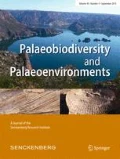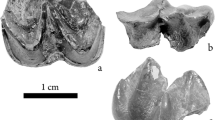Abstract
An old test sample from the Sabuncubeli Formation (Manisa, Turkey) yielded an interesting faunule, which, however, up to now had never been described. In Bornova 183, now inaccessible, five species of micromammal were encountered: the hamsters Eumyarion aff. montanus, E. intercentralis and Cricetodon kasapligili, the squirrel Palaeosciurus fissurae and the talpid Desmanodon sp.. The locality is known to be in superposition to the previously published locality of Sabuncubeli. A new sample of the latter provided five new elements to the fauna: the mole Theratiskos sp., the dimylid Turkodimylus sp., the shrew Oligosorex aff. reumeri, the glirid Glirulus ekremi and a bat Vespertilionidae gen. et sp.. The high diversity of insectivores in the locality confirms a humid environment for Sabuncubeli. Both assemblages are referable to local zone D or MN unit 3. However, differences in the stage of evolution of some faunal elements suggest a considerable time difference, indicating that the Sabuncubeli formation covers at least a major part of this time period.



Similar content being viewed by others
References
Çınar Durgut, N., & Ünay, E. (2016). Cricetodontini from the early Miocene of Anatolia. Bulletin of the Mineral Research and Exploration, 152, 85–119.
Cuenca-Bescós, G. (1988). Revisión de los Sciuridae del Aragoniense y del Rambliense en la fosa de Calatayud-Montalbán. Scripta Geologica, 87, 1–127.
Daams, R., & Freudenthal, M. (1988). Cricetidae (Rodentia) from the type-Aragonian; the genus Megacricetodon. Scripta Geologica, Spec. Issue, 1, 39–132.
Bruijn, H. de (1967). Gliridae, Sciuridae y Eomyidae (Rodentia, Mammalia) miocenos de Calatayud (provincia de Zaragoza, España) y su relación con la bioestratigrafía del área. Boletín Geológico y Minero, 78, 187–373.
Bruijn, H. de, & Saraç, G. (1991). Early Miocene rodent faunas from the eastern Mediterranean area. Part I. The genus Eumyarion. Proceedings of the Koninklijke Nederlandse Akademie van Wetenschappen,94(1), 1–36.
Bruijn, H. de, & Saraç, G. (1992). Early Miocene rodent faunas from the eastern Mediterranean area. II: Mirabella (Paracricetodontinea, Muroidea). Proceedings of the Koninklijke Nederlandse Akademie van Wetenschappen, B, 95(1), 25–40.
Bruijn, H. de, Fahlbusch, V., Saraç, G., & Ünay, E. (1993). Early Miocene rodent faunas from the eastern Mediterranean area .3. The genera Deperetomys and Cricetodon with a discussion of the evolutionary history of the Cricetodontini. Proceedings of the Koninklijke Nederlandse Akademie Van Wetenschappen, B, 96(2), 151–216.
Bruijn, H. de, Mayda, S., Hoek Ostende, L. W. van den, Kaya, T., & Saraç, G. (2006). Small mammals from the Early Miocene of Sabuncubeli (Manisa, S.W. Anatolia, Turkey). Beiträge zur Paläontologie, 30, 57–87.
Dehm, R. (1950). Die Nagetiere aus dem Mittel-Miozän (Burdigalium) von Wintershof-West bei Eichstätt in Bayern. Neues Jahrbuch für Mineralogie, Geologie und Paläontologie, 91(B), 321–428.
Doukas, C.S. (2003). The MN 4 faunas of Aliveri and Karydia (Greece). In N. López-Martínez, P. Peláez-Campomanes, and M. Hernández Fernández (Eds.) Surrounding fossil mammals: Dating, evolution and Palaeoenvironment, volume in honour of Remmert Daams. Coloquios de Paleontologí, 1, 127–132.
Hoek Ostende, L. W. van den (1992). Insectivore faunas from the lower Miocene of Anatolia. Part 1. Erinaceidae. Proceedings of the Koninklijke Nederlandse Akademie van Wetenschappen, Ser B, 95(4), 437–467.
Hoek Ostende, L. W. van den (1995). Insectivore faunas from the Lower Miocene of Anatolia. Part 3: Dimylidae. Proceedings of the Koninklijke Nederlandse Akademie van Wetenschappen, B, 98(1), 19–38.
Hoek Ostende, L. W. van den (1997). Insectivores from the Lower Miocene of Anatolia. part 4: The genus Desmanodon (Talpidae) with the description of a new species from the Lower Miocene of Spain. Proceedings Koninklijke Nederlandse Akademie van Wetenschappen, 100(1–2), 27–65.
Hoek Ostende, L. W. van den (2001a). Insectivore faunas from the Lower Miocene of Anatolia. Part 5: Talpidae. Scripta Geologica, 122, 1–45.
Hoek Ostende, L. W. van den (2001b). Insectivore faunas from the Lower Miocene of Anatolia. Part 6: Crocidosoricinae (Soricidae). Scripta Geologica, 122, 47–81.
Hoek Ostende, L. W. van den (2001c). Insectivore faunas from the Lower Miocene of Anatolia. Part 7: The Kargi assemblages. Scripta Geologica, 122, 83–99.
Hoek Ostende, L. W. van den, Mayda, S., Oliver, A., Madern, A., Hernández-Ballarín, V., & Peláez-Campomanes, P. (2015). Aliveri revisited, a biogeographical appraisal of the early Miocene mammals from the eastern Mediterranean. In L. W. van den Hoek Ostende, P. Peláez-Campomanes, & W. Wessels (Eds.) Old worlds, new ideas. A tribute to Albert van der Meulen. Palaeobiodiversity and Palaeoenvironments, 95(3), 271–284.
Hoek Ostende, L.W. van den, Rojay, B., Aten, C., Bilgin, M., Peláez-Campomanes, P., & Joniak, P. (in press). Early Miocene insectivores of Gökler (Kazan Basin, Central Anatolia, Turkey). In L.W. van den Hoek Ostende, S. Mayda, & T. Kaya (Eds.) Taking the Orient Express? The role of Anatolia in mediterranean Neogene palaeobiogeography. Palaeobiodiversity and Palaeoenvironments, https://doi.org/10.1007/s12549-019-00396-1 [this issue].
Horáček, I. (2001). On the early history of vespertilionid bats in Europe: The Lower Miocene record from the Bohemian Massif. Lynx (n.s.), 32, 123–154.
Jong, F. de (1988). Insectivora from the Upper Aragonian and the Lower Vallesian of the Daroca-Villafeliche area in the Calatayud-Teruel Basin (Spain). Scripta Geologica, Special Issue, (1), 253–285.
Joniak, P., Peláez-Campomanes, P., Hoek Ostende, L.W. van den & Rojay, B. (2017). Early Miocene rodents of Gökler (Kazan Basin, Central Anatolia, Turkey). Historical Biology, doi:https://doi.org/10.1080/08912963.2017.1414211.
Joniak, P., Peláez-Campomanes, P., Mayda, S., Bilgin, M., Halaçlar, K., & Hoek Ostende, L.W. van den (in press). New faunas of small mammals from old Harami mine (early Miocene, Anatolia, Turkey). In L.W. van den Hoek Ostende, S. Mayda, & T. Kaya (Eds.) Taking the Orient Express? The role of Anatolia in mediterranean Neogene palaeobiogeography. Palaeobiodiversity and Palaeoenvironments, http://link.springer.com/10.1007/s12549-018-0349-9 [this issue].
Kälin, D. (1997). The mammal zonation of the upper marine molasse of Switzerland reconsidered: a local biozonation of MN2 - MN 5. In J.-P. Aguilar, S. Legendre, & J. Michaux (Eds.). “Biochrom’97″, Mem Trav EPHE 21, Inst Montpellier, pp 515–535.
Kaya, O., Ünay, E., Göktaş, F., & Saraç, G. (2007). Early Miocene stratigraphy of central west Anatolia, Turkey: implications for the tectonic evolution of the eastern Aegean area. Geological Journal, 42, 85–109.
Mayda, S. (2004). Early Miocene fauna from Western Anatolia (Sabuncubeli-Manisa). 5th International Symposium on Eastern Mediterranean Geology, Thessaloniki, Greece, 14–20 April 2004, 1, 330–332.
Mayda, S. (2010). The Early Miocene carnivores from Sabuncubeli, Turkey. XIX Congress of The Carpathian-Balkan Geological Association, Thessaloniki, Greece, 23–26 September, 246-247.
Meulen, A. J. van der, & Bruijn, H. de (1982). The mammals from the Lower Miocene of Aliveri (Island of Evia, Greece). Part 2. The Gliridae. Proceedings Koninklijke Nederlandse Akademie van Wetenschappen, B, 85(4), 485–524.
Morales, J., Mayda, S., Valenciano, A., De Miguele, D., & Kaya, T. (2019). A new Lophocyonidae Izmirictis cani gen. nov. et sp. nov. (Carnivora, Mammalia) from the Lower Miocene of Turkey. Journal of Systematic Palaeontology. https://doi.org/10.1080/14772019.2018.1529000
Özkaymak, Ç., Sözbilir, H., & Uzel, B. (2013). Neogene-Quaternary evolution of the Manisa Basin: Evidence for variation in the stress pattern of the Izmir-Balıkesir transfer zone, Western Anatolia. Journal of Geodynamics, 65, 117–135.
Pelaez-Campomanes, P., Göktaş, F., Kaya, T., Joniak, P., Bilgin, M., Mayda, S., & Hoek Ostende, L.W. van den (in press). Gördes, a new early Miocene micromammal assemblage from western Anatolia. In L.W. van den Hoek Ostende, S. Mayda, & T. Kaya (Eds.) Taking the Orient Express? The role of Anatolia in mediterranean Neogene palaeobiogeography. Palaeobiodiversity and Palaeoenvironments, https://doi.org/10.1007/s12549-018-0346-z [this issue].
Rosina, V. V., & Rummel, M. (2012). The bats (Chiroptera, Mammalia) from the Early Miocene of Petersbuch (Bavaria, Southern Germany). Geobios, 45, 463–478.
Theocharopoulos, C. (2000). Late Oligocene–middle Miocene Democricetodon, Spanocricetodon and Karydomys n. gen. from the eastern Mediterranean area. Gaia, 8, 1–92.
Ünay, E. (1994). Early Miocene rodent faunas from the eastern Mediterranean area. Part IV. The Gliridae. Proceedings Koninklijke Nederlandse Akademie van Wetenschappen, B, 97, 445–490.
Ünay, E., Atabey, E., & Saraç, G. (2001). Small mammals and foraminifera from the Anatolian (Central Taurus) Early Miocene. Annals of the Carnegie Museum, 70(4), 247–256.
Ünay, E., Bruijn, H. de, & Saraç, G. (2003). A preliminary zonation of the continental Neogene of Anatolia based on rodents. In J.W.F. Reumer, & W. Wessels (Eds.) Distribution and migration of tertiary mammals in Eurasia. A volume in honour of Hans de Bruijn. Deinsea, 10, 539–547.
Uzel, B., Sözbilir, H., Özkaymak, Ç., Kaymakcı, N., & Langereis, C. G. (2013). Structural evidence for strike-slip deformation in the ˙ Izmir–Balıkesir transfer zone and consequences for late Cenozoic evolution of western Anatolia (Turkey). Journal of Geodynamics, 65, 94–116.
Wessels, W., Theocharopoulos, K. D., Bruijn, H. de, & Ünay, E. (2001). Myocricetodontinae and Megacricetodontini from the lower Miocene of NW Anatolia. . Lynx, 32, 371–388.
Ziegler, R. (1993). Die Chiroptera (Mammalia) aus dem Untermiozän von Wintershof-West bei Eichstätt (Bayern). Mitteilungen der Bayerischen Staatssammlung für Paläontologie und Historische Geologie, 33, 119–154.
Ziegler, R. (1994). Die Chiroptera (Mammalia) aus dem Untermiozän von Stubersheim 3 (Baden-Württemberg). Münchner Geowissen–schaftliche Abhandlungen, 26, 97–116.
Ziegler, R. (2000). The bats (Chiroptera, Mammalia) from the Late Oligocene fissure fillings Herrlingen 8 and Herrlingen 9 near Ulm (Baden-Württemberg). Senckenbergiana lethaea, 80, 647–683.
Ziegler, R. (2003). Bats (Chiroptera, Mammalia) from Middle Miocene karstic fissure fillings of Petersbuch near Eichstätt, Southern Franconian Alb (Bavaria). Geobios, 36, 447–490.
Ziegler, R. (2005). The squirrels (Sciuridae, mammalia) of the Miocene Fossil-Lagerstaette Sandelzhausen (Bavaria, S Germany). Neues Jahrbuch für Geologie und Paläontologie-Abhandlungen, 237, 273–312.
Ziegler, R., & Fahlbusch, V. (1986). Kleinsäuger-Faunen aus der basalen Oberen Süßwasser-Molasse Niederbayerns. Zitteliana, 14, 3–80.
Acknowledgements
The authors would like to thank the reviewers Jérôme Prieto and János Hír. We are grateful to Delia van Oijen (Naturalis Biodiversity Center) for access to and helping with the SEM.
Funding
This study was funded by National Geographic grant “Palaeogeography of mammals following the collision of the African and Eurasian plates” (GEFNE 140-15). MB has obtained Synthesys (NL-TAF-5889 and ES-TAF-7048) and Comenius University grants of doctoral students (UK/123/2019). This study was supported by the Ege University (TTM/001/2016) and (TTM/002/2016) to TK, SM and MB. PJ was partly supported by Slovak Scientific Grant Agency (VEGA 1/0702/17) and SRDA (APVV-15-0575) and MB by (VEGA 1/0164/19). LHO acknowledges the support of Tübitak under the visiting researcher program. LHO, PJ, FG and PPC gratefully acknowledge the support of Ege University short-term research grants.
Author information
Authors and Affiliations
Corresponding author
Ethics declarations
Conflict of interest
The authors declare that they have no conflict of interest.
Additional information
Publisher’s note
Springer Nature remains neutral with regard to jurisdictional claims in published maps and institutional affiliations.
This article is a contribution to the special issue “Taking the Orient Express? The role of Anatolia in mediterranean Neogene palaeobiogeography”
Rights and permissions
About this article
Cite this article
Bilgin, M., Joniak, P., Mayda, S. et al. Sabuncubeli too, Bornova, a second micromammal assemblage from the Sabuncubeli section (early Miocene, western Anatolia). Palaeobio Palaeoenv 99, 655–671 (2019). https://doi.org/10.1007/s12549-019-00395-2
Received:
Revised:
Accepted:
Published:
Issue Date:
DOI: https://doi.org/10.1007/s12549-019-00395-2




